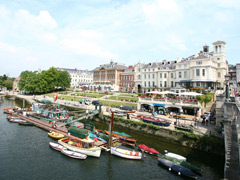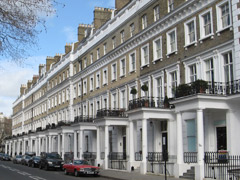


Big Ben, the Houses of Parliament and Buckingham Palace are iconic London landmarks, and tend to be the first port of call for many visitors. But how about seeing London in a different light, by getting to know the capital’s diverse neighbourhoods rather than sticking to popular tourist sights?
All change
Gentrification is altering the character of many neighbourhoods. Places that were once deigned rough are now considered cool, even if problems with unemployment, crime or poverty remain. Willesden and Harlesden have seen a surge of people move in who can’t afford Notting Hill, itself once a bohemian part of town that’s now an exclusive postcode. The borough of Newham has traditionally suffered from high unemployment levels, but the 2012 Olympics promised a boost to the area’s economy. Peckham has the beginnings of an arts scene, and even the once maligned Brixton has a foodie’s haven in Brixton Village. The truth is that rich, poor and everyone in between live side by side, often quite literally, if not necessarily harmoniously (as can be seen in the gated communities in Brixton and Bow).
For a good example of how gentrification has transformed London, head to Wapping. One of the city’s notorious slumlands in the 19th century, the warehouses used to stash cargo arriving via the docks have been converted into luxury apartments that seemingly only high paid investment bankers can afford. Its proximity to the river Thames and Canary Wharf, the pretty cobbled streets and the quaint pubs with insalubrious histories (some were popular for watching the public executions taking place on the other side of the river) have made the area desirable.
Like a lot of the city’s regions, Whitechapel seems to have a split personality; while it’s traditionally been poor (mention East London slums of the 19th century and most people will think of Whitechapel) it’s now an expensive part of town to rent and buy a home. Why? Fashion, mostly, as an arty contingent has made it cool (Tracey Emin’s studio is here, and the Whitechapel Art Gallery is on the high street). It’s also the home of a large Bangladeshi population and the East London Mosque. The mosque has attracted controversy due to some of its preachers stirring up homophobia, linking it to a series of vicious assaults in the area; the culprits have since been banned from speaking here.
On the other side of town, Little Venice is very attractive for a wander, particularly if you walk along the Regent’s Canal, which runs all the way to the Limehouse Basin in the east. It’s so-called because of the canals which you can cruise along thanks to the boat services that run between here and Camden. Despite its proximity to central London it’s quiet and residential, with grand regency houses inhabited by wealthy locals.
\n\nThe suburbs
If you thought tree-lined streets, detached housing and affluent families were typical of suburban London you’d only be partially right. While places like Wimbledon and its accompanying village do indeed fit this stereotype, the lack of things for young people to do in poorer suburbs results in issues like antisocial behaviour. Just look at Croydon, which had the highest number of crimes reported in Britain in 2011.
But anyway, back to leafy retreats, perfectly epitomised by Richmond and nearby Chiswick in south west London. Richmond is most famous for its sprawling park, which is home to many deer. It’s a picturesque, well-to-do neighbourhood (Mick Jagger and Jerry Hall’s family home was here) that also benefits from being beside the river. Chiswick is similar, with the added of bonus of having some of London’s top restaurants.
Forest Hill is another fairly well-off suburb despite being part of one of London’s poorer boroughs, Lewisham. It’s popular with young families and artists – Havelock Road is lined with artist live-in studios which are open to the public. From the top of the hill, particularly within the grounds of the Horniman Museum, there are exceptional views which extend towards the City.
Then there are the suburbs favoured by millionaires, like Totteridge in north London and Chigwell in Essex, both popular with footballers. You probably won’t see much of their mansions over the tall hedges and high security fences, but if you hang around the high streets you might spot a WAG or two.
\n\nMulticulturalism
One of the greatest qualities of a capital city is its diversity, and it’s fascinating discovering pockets like the Australian backpackers in Acton, or the Moroccan families in North Kensington.
Almost 200 different languages are spoken in the borough of Haringey, as this is one of the most multicultural boroughs in London. The area around Turnpike Lane, in particular Green Lanes, is home to the Turkish-Cypriot community, as evidenced by the many Turkish supermarkets and restaurants. Finsbury Park is nearby, another neighbourhood which is fast gentrifying, as a walk past the shops and restaurants of Blackstock Road will reveal.
It doesn’t feel like London at all in Stamford Hill, where there is a population of over 20,000 orthodox Jews, easily distinguished by their top hats and ringlets. Local Jewish schools are single-sex and religion is the main subject; most marriages are arranged. You’ll also find kosher butchers, bakeries and salt beef bagel shops here.
Oddly enough the biggest Korean community in Europe is in New Malden, a suburb not far from Wimbledon. If you fancy Korean food, particularly the famous barbecues, you’re advised to head to one of the local restaurants, as Korean cuisine is surprisingly under-represented in central London.
Admittedly the parts of London covered here merely touch the tip of the iceberg, but your interest beyond zone one should be piqued by now.


